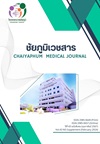Nursing care of dependent patients from cerebrovascular disease in the case of Social Security Scheme : Case Study
Keywords:
Dependency, Intracerebral Hemorrhage, Social Security SchemeAbstract
The purpose of this case study was for the insured person to receive treatment continue rehabilitation in an appropriate period of time. Able to return to work quickly and protect rights under labor protection laws and social security fund in the case of medical expenses Compensation in case of time off from work for the insured person. The study was conducted in patients with hemorrhagic stroke is a dependent person and requires continuous care in Mueang District, Chaiyaphum Province. Social security rights Chaiyaphum Hospital, 1 case. Using nursing theory using the nursing process according to Roy's adaptation model 6 steps namely assessment of behavior, Assessment of stimuli, Nursing diagnosis, Goal setting, Intervention and Evaluation
The results of the study found that nursing diagnosis and nursing care for patients at home physical, unable to take care of himself regarding daily activities due to left limb weakness, Motor Power grade 1-2, right side grade 4 risk of pressure sores due to limited body movement. Risk of joint stiffness due to decreased physical movement. Psychologically, the patient has anxiety because he is unable to help himself. Social and economic aspects patients and caregivers feel isolated due to the sudden loss of social status.
Summary of results of continuous follow-up care, 5 times. Receive medium-term care up to entry into the long-term care system after 6 months. Receive rights for people with disabilities. Received coordination from the Social Security Center, Compensation Fund. Currently undergoing continuous rehabilitation at home so that he can return to work.
References
สำนักงานหลักประกันสุขภาพแห่งชาติ. รายงานผลการดำเนินงานของรัฐบาล พลเอกประยุทธ์ จันโอชา นายกรัฐมนตรี. กรุงเทพฯ : สำนักงานหลักประกันสุขภาพแห่งชาติ. 2554.
สถาบันประสาทวิทยา. คู่มือโรคหลอดเลือดสมอง สำหรับประชาชน. พิมพ์ครั้งที่ 3. กรุงเทพฯ : สถาบันประสาทวิทยา กรมการแพทย์ กระทรวงสาธารณสุข. 2556.
สถาบันประสาทวิทยา. แนวทางการฟื้นฟูสภาพผู้ป่วยโรคหลอดเลือดสมอง. กรุงเทพฯ : สถาบันประสาทวิทยา กรมการแพทย์ กระทรวงสาธารณสุข. 2550.
สำนักงานสาธารณสุขจังหวัดชัยภูมิ. รายงาน HDC กลุ่มรายงานมาตรฐาน ส่งเสริมป้องกัน. [อินเทอร์เน็ต]. 2566 [เข้าถึงเมื่อ 10 มกราคม 2566]. เข้าถึงได้จาก: https://cpm.hdc.moph.go.th/hdc/reports/report.php?&cat_id=6a1fdf282fd28180eed7d1cfe0155e11&id=b717285d1ebab38e6cf30ca2846317cd.
จุฬาลงกรณ์มหาวิทยาลัย. เอกสารประกอบการสอนรายวิชา Nursing theory. กรุงเทพฯ : คณะพยาบาลศาสตร์ จุฬาลงกรณ์มหาวิทยาลัย. 2555.
สมาคมความดันโลหิตสูงแห่งประเทศไทย. แนวทางการรักษาโรคความดันโลหิตสูงในเวชปฏิบัติทั่วไป. กรุงเทพฯ : สมาคมความดันโลหิตสูงแห่งประเทศไทย. 2562.
สมาคมโรคเบาหวานแห่งประเทศไทย. แนวทางเวชปฏิบัติสำหรับโรคเบาหวาน. กรุงเทพฯ : ศรีเมืองการพิมพ์ จำกัด. 2566.
ศูนย์สมเด็จพระสังฆราชญาณสังวรเพื่อผู้สูงอายุ จังหวัดชลบุรี. คู่มือการดูแลผู้ป่วยโรคหลอดเลือดสมองระยะฟื้นฟู. กรุงเทพฯ : กรมการแพทย์ กระทรวงสาธารณสุข. 2554.
สำนักงานหลักประกันสังคมกระทรวงแรงงาน. คู่มือสำหรับประชาชนตามพระราชบัญญัติการอำนวยความสะดวกในการพิจารณาอนุญาตของทางราชการ. [อินเทอร์เน็ต]. 2566 [เข้าถึงเมื่อ 10 มกราคม 2566]. เข้าถึงได้จาก:https://www.sso.go.th/wpr/assets/upload/files_storage/sso_th/a553b031b 68425e88d2e816997229fa8.pdf.
Downloads
Published
Issue
Section
License
Copyright (c) 2024 Chaiyaphum Medical Journal

This work is licensed under a Creative Commons Attribution-NonCommercial-NoDerivatives 4.0 International License.





